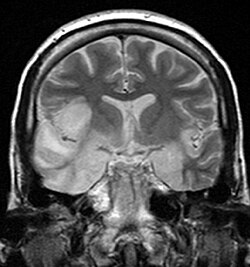Acute viral encephalitis
From WikiLectures
The result of acute viral encephalitis are neuronal and glia defects occurring with inflammation and edema.
Etiology[edit | edit source]
- Mumps, HSV, VZV, EBV.
- Substantial link to the vector: tick – tick encephalitis, Russian spring encephalitis; mosquito - western equine disease (USA), western Nile encephalitis (Africa).
- Post-infectious encephalitis – follow childhood infections (measles, chickenpox, rubella), it is not a direct effect of the virus.
Clinical manifestations[edit | edit source]
- General manifestations ("influenza"): muscle pain, fever, headache, meningeal reactions, cerebrospinal fluid cell proliferation.
- Symptoms of brain impairment - focal/diffuse, according to location.
- With hemisphere involvement → epilepsy, involuntary movements, paresis, confusion, speech disorders.
- Rhombencephalits = defects in cerebellar and brainstem structures.
- Mesencephalic defect→ oculomotoric and autonomic disorders.
- Cerebellar defect→ ataxia, dysarthria.
- Brainstem defect → nystagmus, quadruparesis, cranial nerve palsy.
- Spinal cord defect→ mixed motor, sensitive and autonomic dysfunction.
Prognosis[edit | edit source]
- Usually lasts for several weeks;
- the prognosis depends on the type of virus;
- mortality HSV infection 20-30%, in mumps only 2%;[1]
- also the neurological consequences vary in severity.
References[edit | edit source]
Related articles[edit | edit source]
- Encephalitis
- Viral encephalitis: Rabies, Polio, Herpetic encephalitis, tick-borne encephalitis
Literature[edit | edit source]
- ↑ SEIDL, Zdeněk a Jiří OBENBERGER. Neurologie pro studium i praxi. 1. vydání. Praha : Grada Publishing, 2004. ISBN 80-247-0623-7.

